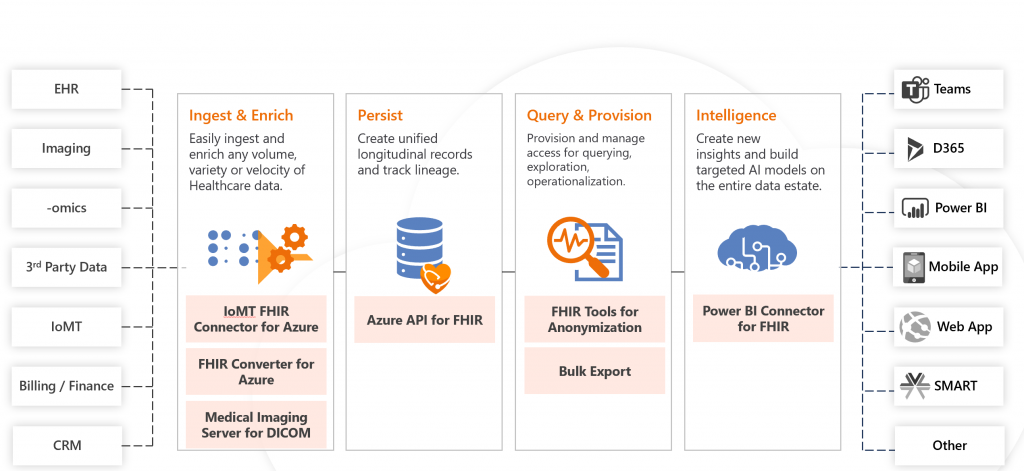In the last years we have seen a tremendous adoption of Artificial Intelligence in different industries. And when talking about A.I., I don’t mean simple mathematics, decision trees or if-else statements that are being positioned as intelligent systems. With A.I., I refer to an artificially intelligent system which makes predictions or takes actions based on patterns in existing data and can learn from its errors to increase accuracy.
With the increasing administrative burden on our caregivers, the rising GDP costs of healthcare, ageing population and patients demanding more ease and better tools. There is a need to support our healthcare system with a competent (scalable) A.I. friend at our side.
I am excited and proud to see the progress and results that are already being achieved in healthcare today. If we look at Finland’s largest hospital district called HUS. They developed an A.I. system, which can predict sepsis with babies 24 hours before it would haven been detected in a blood test. This greatly improves survival rates and is a perfect example on how caregivers and A.I. can work together for better care.
When we look at Italy, where IRCCS San Raffaele created an A.I. model in less then a year. They did this to Identify COVID-19 patients who are at highest risk. The AI-SCoRE platform that IRCCS San Raffaele developed, allows for the collection, processing, management and use of structured and medical imaging data with total respect for patient privacy. Which ultimately leads into better care for patients.
Or how Nuance, together with Microsoft Research is reimagining the patient-doctor conversation in the exam rooms. An A.I. who is listening to clinical conversations between doctors and patients. and integrates this structured content with the EHR. Which allows physicians to spend more face-to-face time with patients and decreases the administrative burden of the doctor.
Commitment to healthcare
When working for a company as Microsoft, I am grateful that I can experience our commitment to healthcare. We are continuously improving and enabling A.I. and data interoperability across our different clouds. Going from Azure, Office365, Dynamics365 to the Power Platform. A common denominator which enables all of this is FHIR. FHIR or Fast Healthcare Interoperability Resources is a healthcare standard for exchanging healthcare information, and is a crucial point when working with healthcare data. It enables to ingest data from different sources into a standardized data format to create your golden patient record.

Project InnerEye
Next to FHIR, Microsoft is also democratizing A.I. in medical imaging , empowering developers, researchers, and partners to accelerate the adoption of machine learning. With Project InnerEye, Microsoft open-sourced machine learning technology to build innovative tools for automatic, quantitative analysis of three-dimensional medical images.

When combing FHIR with the InnerEye toolkit we can provide an end to end solution where healthcare organizations can combine their structured and unstructured data with real time inferencing of DICOM images. The A.I. supports caregivers in the delineation of images that can be used in radiotherapy treatment. Accelerating clinicians’ ability to perform radiotherapy planning 13 times faster.

Text Analytics for Health
Not to forget the big amount of healthcare data in the form of unstructured text, such as doctor’s notes, medical publications or clinical trial information. Healthcare organizations face an incredible challenge in trying to identify and draw insights from all that information. And when you want to get insights you need to get this data in a structured format. That’s why Microsoft introduced Text Analytics for health, a new preview feature of Text Analytics in Azure Cognitive Services that enables organizations to process and extract insights from unstructured medical data. Trained on a diverse range of medical data.

Privacy, Security and Trust
All of this is not possible without the needed trust, security and with the highest privacy standards. When organizations are entrusting us with their most valuable and irreplaceable asset, their data. They must trust that confidential information is protected, that it’s held and managed securely and incompliance with regulations and laws, and that its privacy is protected. To provide these standards, Microsoft is continuously providing tools and technology that can support these needs.
Differential privacy
With differential privacy organizations can extract useful insights from datasets containing personal information and offer stronger privacy protections. This is achieved by introducing “statistical noise”. The noise is significant enough to protect the privacy of any individual, but small enough that it will not impact the accuracy of the answers extracted by analysts and researchers. Smartnoise which is an open source toolkit which uses state-of-the-art differential privacy (DP) techniques to inject noise into data. Organizations can make use of this technique to provide strong privacy assurances, preventing data leaks or re-identification of individuals in a dataset.
Homomorphic encryption
Homomorphic Encryption refers to a type of encryption technology that allows computation to be directly on encrypted data, without requiring any decryption in the process. And to make this technology easy to use and available for everyone Microsoft open sourced the Microsoft Seal toolkit, which contains an API with homomorphic encryption technology. This enables organizations to build end-to-end encrypted data storage and computation services where the customer never needs to share their key with the service.
Confidential Compute
In the last years we have been using mechanisms to safeguard data at rest and in transit. However, data in use was always a different challenge.
With Confidential compute Microsoft provides data-in-use protection assurances, using a hardware-based Trusted Execution Environments (TEE). With Confidential Compute you increase security guarantees for the executing code and the data in memory. It protects the application and data from unauthorized access or modifications from system admins, service providers, or infrastructure providers.
With this TEE environment the application and the owner of the data is in full control of who can see, execute, and compute on the data. Having a defense-in-depth strategy for protecting the applications and data through confidential computing enables new possibilities such as rich data collaboration between multiple parties, secure key management, in-memory databases, and many more.

Bring Your Own Key (BYOK)
Another important aspect when working with data is the capability to encrypt with your own key. With the Bring Your Own Key concept, Microsoft allows customers to import keys from on-premises HSMs to Key Vault HSMs. Customers can make use of on-premises HSMs to generate keys and import them into the Azure Key Vault. Many customers prefer to use on-premise HSMs to generate keys to meet regulatory or compliance requirements.
Responsible A.I.
Artificial Intelligence brings great opportunity, but also great responsibility. We’re at that stage with AI where the choices we make need to be grounded in principles and ethics – that’s the best way to ensure a future we all want.
Microsoft CEO Satya Nadella
A.I. brings great opportunity in healthcare, but also great responsibility, which is why Microsoft has already adopted their own set of self-regulatory principles and measures which are based on six different topics, which are described below:
- Transparency: A.I. systems should be understandable.
- Fairness: A.I. systems should treat all people fairly.
- Accountability: People should be accountable for A.I. systems.
- Privacy & Security A.I. systems should be secure and respect privacy.
- Reliability & Safety: A.I. systems should perform reliably and safely.
- Inclusiveness: A.I. systems should empower everyone and engage people.
when working with our healthcare customers, we put these principles in practice with every A.I. project we engage on.
To conclude, we are living in amazing times where technology is accelerating at immense speed and where we have the tools to improve our healthcare system in many ways. I hope this article has shown you what is available today, to get you started with your A.I. journey!
Bert
Sources
- Healthcare expenditure across the EU: 10% of GDP – Products Eurostat News – Eurostat (europa.eu)
- How differential privacy enhances Microsoft’s privacy and security tools: SmartNoise Early Adopter Acceleration Program Launched – Microsoft On the Issues
- What is artificial intelligence? | Microsoft Azure
- IRCCS San Raffaele: Identifying the COVID-19 patients at highest risk with AI (microsoft.com)
- Introducing Text Analytics for Health – Microsoft Tech Community
- Responsible AI principles from Microsoft
- Differential Privacy – Microsoft AI Lab
- Microsoft SEAL: Fast and Easy-to-Use Homomorphic Encryption Library
- Project InnerEye – Democratizing Medical Imaging AI – Microsoft Research
- Azure confidential computing | Microsoft Azure
- Brendan Burns: Everything You Need to Know About Confidential Computing and Containers – The New Stack
- Key Vault bring your own key (BYOK) is now generally available | Azure updates | Microsoft Azure
- Responsible AI principles from Microsoft
- Guidelines released for ethical and trustworthy AI – EU Policy Blog (microsoft.com)

